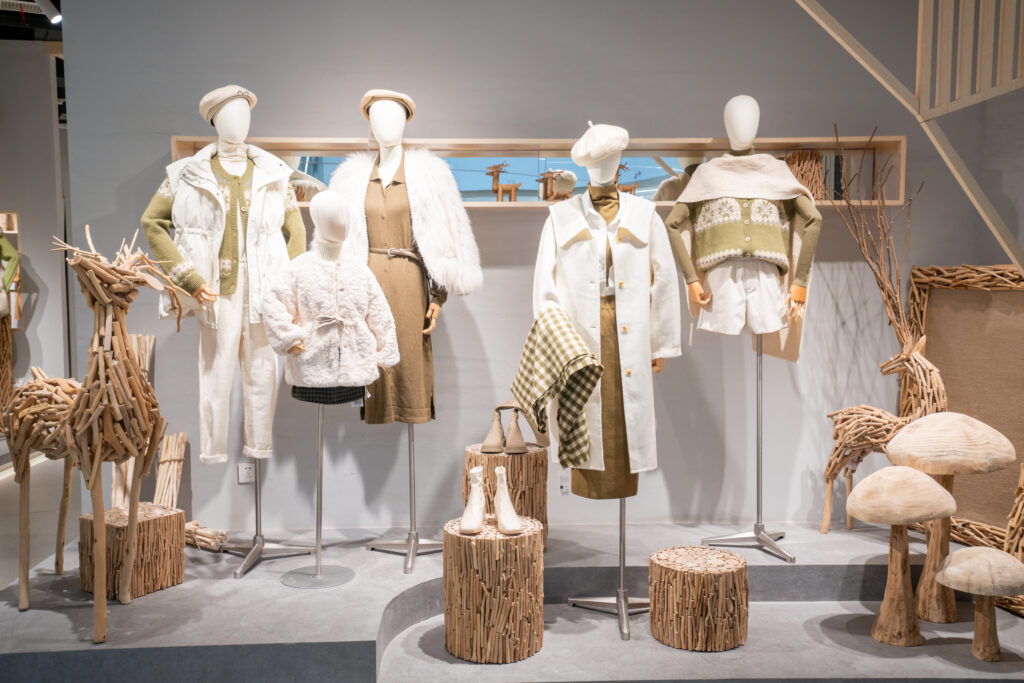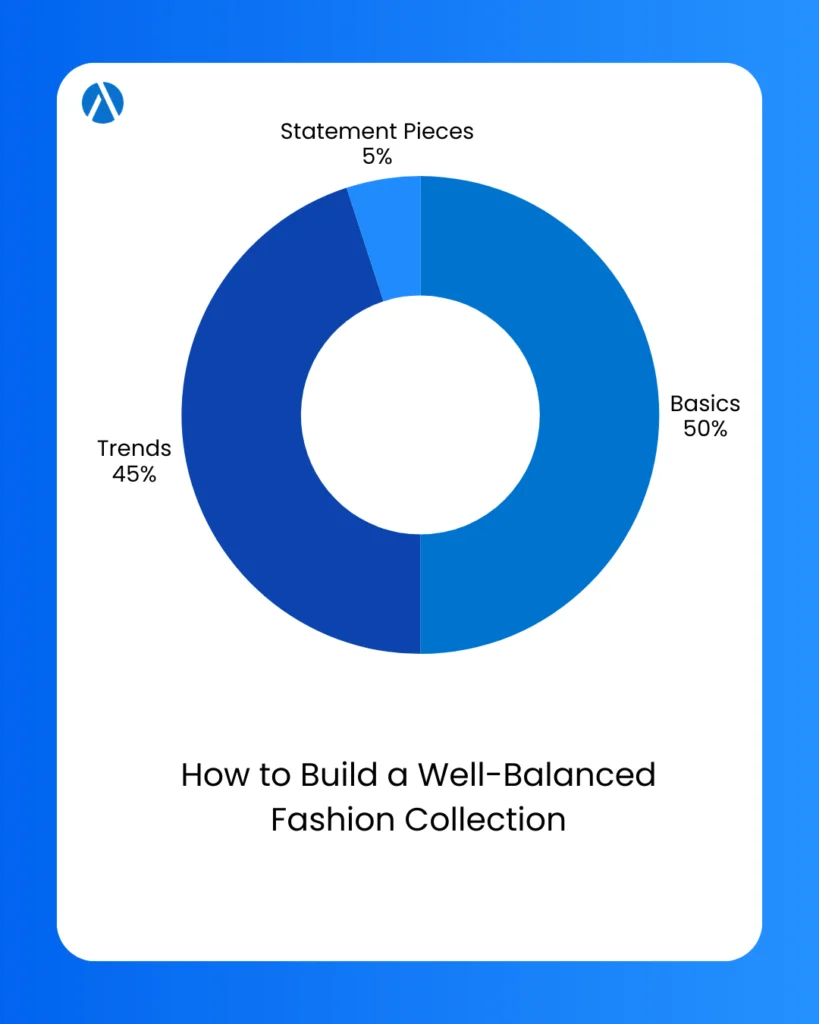Summary:
- A fashion product mix involves strategically planning the diverse pieces that will comprise your collection.
- To enhance the creative process, categorize your products into three groups: basics, trends, and concepts.
- Audaces Fashion Studio offers a streamlined solution for digitally creating and launching fashion collections. Try the Audaces360 multi-solution for free today!
In the realm of fashion, every step in creating a collection should harmonize seamlessly. From selecting a theme to crafting the individual pieces, each phase should reflect your brand’s values and meet your customers’ expectations.
To ensure the success of your collection launch, you must consider various factors, including the fashion product mix.
Continue reading to delve deeper into this topic!
What is a fashion product mix?

The fashion product mix is a well-balanced blend of garments, styles, and prints. While it may consist of numerous elements, careful planning is essential to ensure that the collection’s various pieces harmonize with one another.
Sumário
This mix serves as a reflection of the assortment of products within a collection, catering to the diverse requirements of the target audience. Its purpose is to group and categorize the attire based on their design and intended usage.
Learn more: 4 top tips for a successful fashion collection launch
Why creating a fashion product mix benefits your brand?
Having a well-thought-out fashion product mix is highly advantageous for your brand. Products with conflicting purposes can complicate the customer’s buying decision, resulting in issues like excessive inventory buildup.
That’s why the fashion product mix plays a pivotal role for anyone launching a collection. It empowers customers to make choices that complement their outfits, promoting the purchase of coordinated pieces.
When curating your collection, prioritize pieces that naturally go together, enhancing the appeal for your audience.
Additionally, achieving the right balance and variety within your product mix is essential. Ensure that each type of piece is proportionate in quantity, and include styles that have a strong appeal and can practically sell themselves.
Learn more: How to choose the best clothing collection names
How to organize a fashion product mix?
Questions like “How many pieces should I produce?” and “What’s the right mix of prints, styles, and sizes?” are common concerns.
To address these and other queries effectively, your first step should be gaining a deep understanding of your audience’s behavior and consumption patterns.
It’s important to note that an excessively diversified collection doesn’t guarantee record-breaking sales. To excel in this endeavor, you must focus on and consider several key aspects, including:
Width
Width pertains to the variety of product lines your brand intends to introduce and cover. To ensure the cohesiveness of your fashion collection, it’s advisable to have between 5 and 10 categories.
The fundamental concept behind the fashion product mix is to ensure that your collection effectively resonates with your target audience, piquing their interest.
Consistency
It’s imperative that everything you offer to your customers reflects your brand identity. Consistency, in this context, refers to how product lines interrelate in terms of usage, production, and distribution.
Don’t forget: this principle applies not only to your collection but also to the development of your brand as a whole.
Quantity
You may be pondering, “How many pieces should I include in my collection?” Generally, a collection of 12 pieces is a sound approach. However, there are smaller alternatives, such as capsule collections, which typically comprise 8 pieces.
When planning this aspect, consider distributing the pieces proportionally according to their type. In a 12-piece collection, you might offer, for instance, 4 different blouse styles, 3 pants, 2 shorts, 2 skirts, and 1 jacket.
Alternatively, in the context of capsule collections, you can categorize the pieces as follows: 4 basic styles, 3 trendy ones, and 1 “concept”. Explore further details about this categorization below!
Meet the ‘pyramid’ method for composing a superb fashion product mix

When planning a fashion collection, it’s crucial to consider not only your brand identity but also the consumption preferences of your target audience.
For instance, do your potential customers prefer trendy pieces endorsed by fashion influencers, or do they opt for timeless, basic, yet elegant items? To streamline the creative process, you must categorize your products into three distinct groups.
The selection of segments within these groups should be intricately tied to your brand’s positioning. You can organize it into these major categories
Basics
Basic pieces are a constant presence in every collection, undergoing subtle updates as trends evolve. They form an integral part of people’s everyday wardrobes and, owing to their combination of affordability and timeless design, require fewer sales efforts than other collection components.
In the wake of the pandemic, there has been a noticeable shift in consumer preferences toward greater comfort in clothing. As a result, the proportion of basic pieces in collections has increased from its former 25% to a substantial 50%, underscoring the evolving habits of customers.
Trends
Trendy pieces are the direct response to runway shows, fashion websites, and the social media profiles of fashion enthusiasts. They often feature distinct colors, prints, and cuts with each new season.
The lifecycle of trendy pieces typically spans just one to two collections. Once new trends emerge, they become saturated and lose their appeal to customers.
Within your collection, you can allocate anywhere from 45% to 65% of the pieces to this segment, capitalizing on the surge in trends. By the way, this segment allows for the highest percentage of markup on the pieces!
Learn more: Decode dressing trends and how to apply them to your designs
Statement pieces
Concept pieces are the embodiment of the collection’s style and essence. These items usually showcase innovative designs crafted by stylists to captivate the audience and ignite fresh inspiration. A prominent example of a brand that skillfully employs this strategy is Balenciaga.
These pieces take center stage in storefront displays, catalogs, and fashion shows, catching the consumer’s eye and, at times, eliciting a sense of wonder or astonishment. Typically, approximately 5% of the collection is reserved for this category.

3 tips for crafting an exceptional fashion product mix
1. Track customer’s behavior
Keeping a close watch on your audience’s consumption habits is essential for making informed decisions when it comes to your product mix.
As you develop your pieces, it’s crucial to discern which trends resonate with your target demographic.
Whether they favor timeless classics, basic essentials, or hyper-creative styles often seen on fashion runways, understanding their preferences is the cornerstone of a successful product mix.
Your brand’s loyal customers can serve as an invaluable thermometer, offering insights into what is likely to work for your upcoming collection.
2. Embrace concept pieces
Although concept pieces represent a smaller portion of your collection, they play a strategic role in shaping a well-rounded fashion product mix.
These items tend to be more expensive and often feature intricate details, making them exclusive and appealing to a select group of consumers.
3. Promote it on social media
Social media is a powerful ally for promoting your fashion collection.
Through these platforms, you can showcase your product mix in detail and suggest various outfit combinations using creative photos and videos. Engaging with your audience on social media can boost your collection’s visibility and desirability.
Fashion product mix examples
Fashion product mixes can vary depending on the niche and focus of the brand. Here are some common examples of fashion product mixes:
- Tops (blouses, shirts, and t-shirts)
- Bottoms (skirts, shorts, and pants)
- Single pieces (dresses, overalls, and jumpsuits)
- Outerwear (jackets and sweaters).
However, companies that work with beachwear may have a different mix, consisting of:
- Bikinis, bathing suits, and swimming trunks
- Sarongs and beach cover-ups
- Visors, caps, and hats
- Hairpins
- Bags.
Companies that operate in the footwear sector can focus on:
- Sneakers
- Boots
- Flat sandals
- Flip flops
- Clogs
- Socks
- Bags
- Accessories.
How to plan a fashion product mix with Audaces technologies?

Audaces offers the most comprehensive technologies in the market to streamline your fashion product mix planning.
Here’s an overview of one of our systems designed to enhance the efficiency of your business:
Audaces Isa
Managing the product lifecycle is a critical aspect of launching a successful fashion collection, and Audaces Isa was designed to support individuals in this process.
This advanced tool offers a comprehensive solution for tracking the entire lifecycle of your products, and efficiently managing the technical aspects of your collection.
Audaces Isa also ensures that your production schedule is executed on time, enabling you and your team to make more informed decisions.
Audaces Fashion Studio
In addition to Audaces Isa, Audaces Fashion Studio is an excellent choice for those looking to develop their fashion product mix!
This tool enables you to create and recreate models within a three-dimensional environment, saving valuable time in the sketch development process.
Furthermore, it offers the opportunity to integrate the creation and production stages with the cutting-edge 4.0 technology for apparel, known as the Audaces360 multi-solution.
Download our e-book for free and find out how Audaces can help you boost your apparel business:
FAQ
A fashion product mix refers to the assortment of garments, styles, and designs that make up a brand’s collection.
The key components typically include basic, trendy, and concept pieces. Basics are timeless items, trendy pieces follow current fashion trends, and concept pieces represent the brand’s essence.
Because it ensures that a collection resonates with the target audience, satisfies their diverse needs, and promotes a cohesive brand identity, ultimately influencing purchasing decisions.










